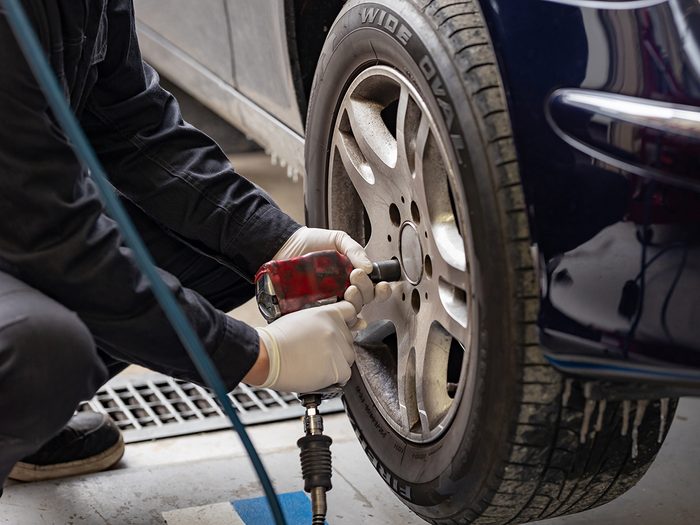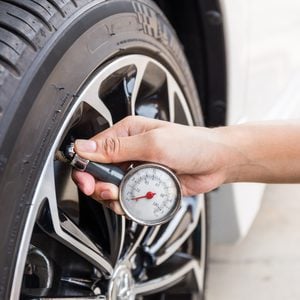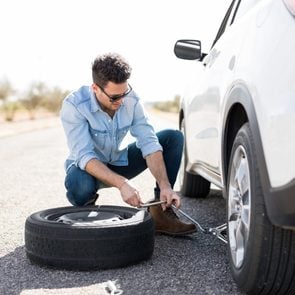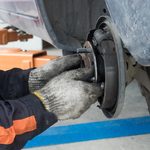What It Means If You See a Red or Yellow Dot on Your Tires

If you had new tires installed recently, red and yellow paint dots on the sidewall are perfectly normal. Here's why they're there.
Do those red dots on tires mean the tires are on sale? Is there something wrong with tires marked with yellow dots? Do the dots indicate where or when the tires were made?
Nope, nope and nope. Here is what’s really going on with these dots: Because it’s nearly impossible to manufacture a perfectly balanced, perfectly round tire, manufacturers identify any irregularities with these dots of paint. The dots then help service technicians correctly install and balance the tire. Properly balanced tires and wheels are critical to driving comfort and safety, and those paint dots help make that happen.
Note: When a tire (the black rubber part that wears out) is mounted onto a wheel (the round metal part the tire is attached to) it’s referred to as a tire/wheel assembly.
Where Are the Paint Dots Placed?
The yellow dots identify where a tire weighs the least—the lightest point on a tire. The yellow dot should be directly across from the valve stem, which is the wheel’s heaviest point.
The red dots identify where the tire is flattest—the lowest point on a tire. The red dot should be directly across from the highest point of the wheel, which is usually indicated by a coloured dot or a notch on the wheel.
If a tire has a yellow and red dot, the red dot takes precedence when balancing the tire.
Why Are These Tire Dots Important?
The yellow and red dots indicate inconsistencies in a tire’s weight, construction and structure, which can cause them to vibrate when spinning. Vibrating, unbalanced tires can negatively affect ride quality, fuel economy and braking effectiveness, among other things. A vibrating tire/wheel assembly makes controlling your vehicle more difficult, especially at high speeds, and can increase stopping distance.
A hopping tire/wheel loses full contact with the road surface generating less friction when braking. Keep in mind, the section of tire that actually touches the road, called the contact patch or footprint, isn’t much larger than the palm of your hand.
What Does Wheel Balancing Do?
Wheel balancing spins a tire/wheel assembly to identify the location(s) where weights need to be placed to eliminate vibrations and help tires roll smoothly. Out-of-balance tires may develop dangerous bald spots, which negatively affect tread wear, and shorten tire life. Out-of-balance tires can also cause premature suspension component failures.
The two most common types of wheel balancing are dynamic and match-balancing. During dynamic balancing, wheel weights are added to counteract tire imbalance that results in tire hop. Match-balancing matches the tire’s low point to its wheel’s high point, providing a smooth ride.
Tires are expensive. When having your new tires mounted and balanced, ask your tire installation professional if their wheel balancing equipment can match-balance tires. This is especially important if your wheels lack any markings. (Here are more tips to extend the life of your tires.)
What Causes a Tire To Get Out of Balance?
Tires become unbalanced when the weight around the tires and wheels is no longer evenly distributed. These are some possible causes:
- Tire/wheel assembly becomes lighter as tires wear.
- Tires are over or under-inflated.
- Improper alignment results in abnormal tire wear.
- A wheel weight has fallen off.
- An improper wheel or tire repair.
- Leaky valve stem replacement.
- Cold mornings cause “flat-spots.”
- The car has been sitting in one place too long.
- The wheel is damaged from hitting a pothole or bouncing into a curb.
To extend tire life and even out wear, check tire pressure and rotate tire/wheels every 8,000 to 13,000 kilometres. However, If you notice vibration while driving, you’ll need to have the pros balance the tires.
Next, find out what the numbers on your tires mean.






